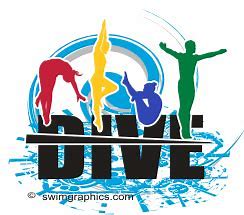 Diving Age Group Information, Competition Requirements and Scoring
Diving Age Group Information, Competition Requirements and Scoring
Age Groups: Summer
There are two age groups for both girls and boys. Those who are 12 and under are in the Junior category. Those who are 13 and over are in the senior category.
Juniors
Each diver will perform 3 dives in order to compete in dual meets: 1 voluntary and 2 optional.
Voluntary dives include: front dive, back dive and inward. The voluntary dive is assigned to each meet on a rotating basis.
Optional dives must come from two different categories
Seniors
Each diver will perform 4 dives in order to compete in dual meets: 1 voluntary and 3 optional.
Voluntary dives include: front dive, back dive, reverse dive and inward. The voluntary dive is assigned to each meet on a rotating basis.
Optional dives must come from three different categories
Voluntary Dive (Summer League) - Each meet is assigned a voluntary dive on a rotating basis starting with the front. The VOLUNTARY designation means that the diver is required to perform a dive from the assigned category. So, if the voluntary dive is 100 (Forward), the diver may perform a front dive, front somersault, front one and a half and so one.
Age Groups: Winter
11 and Under
Each diver will perform 3 dives in order to compete in dual meets: 1 required and 2 optional.
Required dives include: front dive and back dive. The required dive is assigned to each meet on a rotating basis.
Optional dives must come from two different categories
12 - 14
Each diver will perform 4 dives in order to compete in dual meets: 1 required and 3 optional.
Required dives include: front dive, back dive and inward dive. The required dive is assigned to each meet on a rotating basis.
Optional dives must come from three different categories
15 and Over
Each diver will perform 5 dives in order to compete in dual meets: 1 required and 4 optional.
Required dives include: front dive, back dive, reverse dive and inward dive. The required dive is assigned to each meet on a rotating basis.
Optional dives must come from four different categories
Required Dive (Winter League) - Each meet is assigned a required dive on a rotating basis starting with the front. The REQUIRED designation means that the diver is required to perform the designated dive: Front dive, Back dive, Reverse dive, Inward dive in the position of their choice.
The following is a brief description of the dives that must be learned in order to compete.
Diving Categories: Each dive has a number applied to it for descriptive purposes

100 - Front
200 - Back
300 - Reverse
400 - Reverse
5000 - Twisting
For all categories (100-400), the first digit indicates the dive category. The third digit indicates the number of revolutions with each progression representing one half of a turn.
So for example, 101 is a forward dive and 102 is a forward somersault.
The twisting category is a bit different. All twisting divers are in the 5000s. The next digits represent the direction of the dive (front, back, reverse or inward), followed by the number of revolutions followed by the number of twists.
So a 5121 is a forward dive, one somersault with one half twist.
There are four positions for each dive
A - Straight: the body maintains a straight position through the hips and knees throughout the dive
B - Pike: the body is bent at the hips while maintaining straight knees while rotating through the dive
C - Tuck: the body is bent at the knees and the hips into a tight ball while rotating through the dive
D - Free (twisting dives only): The body is briefly in a pike position before moving into a straight position
So, a 101 B is a forward dive in the pike position.
Degree of Difficulty
Each dive is assigned a degree of difficulty. For example, a front dive in tuck is rated at a 1.2 (101C 1.2) and a front one and a half tuck is rated at a 1.6 (103C 1.6).
The degree of difficulty is used in scoring dives so that divers are given "credit" for performing more difficult dives.
Scoring
Divers are awarded points, 0-10 in .5 increments by 5 judges (two from the visiting team and three from the home team).
The high score and the low score are dropped. The remaining scores are then added together and multiplied by the degree of difficulty.
Elements taken into consideration:
Height above the board
Distance from the board upon entry - not too far, but also not too close
Did the diver demonstrate control?
Did the diver enter the water cleanly and in a vertical position?
Did the diver complete the announced dive in the correct position.
If the dive is feet first entry (ie, single somersault), the feet must hit the water before any other part of the body and the hands must be down at the sides
If the dive is head first (ie one and a half somersaults), the head/hands must hit the water before any other part of the body.
Parents of current divers act as judges for diving events. If you are new to diving, it is strongly encouraged that you partner with parents who have been with PAC diving for a time. While judging can be intimidating, it can be learned after spending some time watching the sport. At times, the winter and/or summer leagues offer clinics to provide judging training. As I become aware of these opportunities, I will share the information with the parents of all registered divers.

